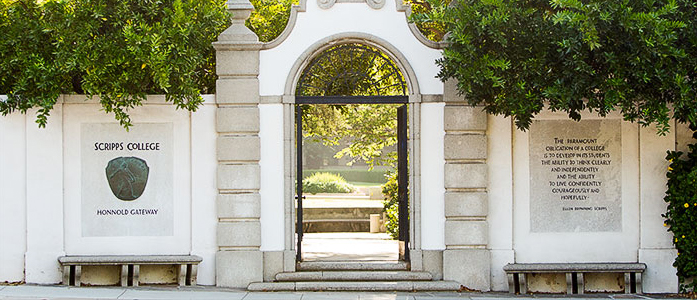Hi everyone!
Sam, Siena, and Ana here! It’s application season, and that can be stressful and confusing. We’re here to try to demystify some of the process. We will be covering the general aspects of what applying to colleges in the US looks like. Sam will be discussing deadlines and differences between application submission times. Ana will cover financial aid, and Siena will describe the Common App and writing. If you have any questions about what we’ve written or about the application as a whole, please don’t hesitate to reach out to the Ambassadors or the Admissions or Financial Aid Offices.

Early Decision vs Regular Decision (and Early Action)
A common question prospective students have is “did you apply to Scripps regular decision or early decision and how did you figure it out?” Hopefully, this section can help you understand what each of those things means and a way to go about making that decision.
In admissions for first-year applicants, colleges offer all or some of a few different times to submit your application. The most common ones are early decision 1, early decision 2, early action, and regular decision. The early decision 1 application for Scripps is due by December 1st. An early decision 2 application for Scripps is due by January 5th. Both early decisions 1 and 2 are binding, meaning if you are accepted you will go there and have to pull out any other applications you might have sent in. You also can only apply to one school for each of these deadlines. In contrast, early action is the opportunity to apply early to a school but it is not binding (Scripps doesn’t offer this option). A regular decision application for Scripps is due January 5th and is probably what people think of when sending an application to a school.
But what does it mean to a college when you apply early? Applying ED 1 is for people who know that Scripps is their top college and they wouldn’t want to go anywhere else. Applying ED 2 is for people who have heard back from their ED 1 college and got denied and now Scripps is their top college. It could also be for people who want more time to prepare their application or to be able to show their first semester grades. Regular decision is for people who are interested in the school but haven’t made their final decision and want to hear back from colleges first. Regular decision is also helpful if you want a chance to compare financial aid packages.
When thinking about making the decision, think about how the idea of going to that college makes you feel. Also, think about how many colleges you feel this way about. Picking a college can be really stressful and hard or it can be an easy decision. Either of these responses is normal to have and you shouldn’t feel bad for either of these responses. When making this choice sometimes it can be nerve-wracking and sometimes after you submit or before you submit you might second guess yourself and that is also normal.
For transfer students it is a little different, for more information on that follow this link: https://www.scrippscollege.edu/admission/apply/transfer-applicants
Financial Aid/FAFSA/CSS Profile
Applying for Financial Aid may seem scary but it really is not once you get started. There are two different forms needed to fill out in order to receive financial aid at the colleges you are looking to apply to. If you are a US citizen you should create a FAFSA account via https://studentaid.gov/h/apply-for-aid/fafsa and fill out the questions in the form. These questions will begin with your personal information and that of your parents and then about your and your parents’ tax returns from previous years. (Note: your parents do not need to be citizens for you to complete the FAFSA.) Once you have completed the FAFSA a parent will have to create an account as well and sign off on the document, once you have both signed you may send them to all the colleges you are applying to in order to receive aid.
After the FAFSA you should complete the CSS Profile which you can find at: https://cssprofile.collegeboard.org. This form will ask for more information about you and your legal guardians including personal information and job positions but also the annual income of everyone in the household and the number of assets in the name of people within the family. I suggest you create an account if you haven’t already and look over the questions in order for you parents to have the information available to you once you sit down to fill out the form together. This form may be long and a little tedious but if you select a day with your parents to sit and work on it together it should be done in one afternoon.
Finally, throughout your process of completing your financial aid profiles you may also be asked to submit additional forms like tax returns, foreign tax returns, company tax returns (if a family member owns a company) and other documents showing the financial situation of you and your family. I encourage you to submit your financial aid profiles and documents before the deadlines colleges have so if an additional document or information is needed you still turn it in on time.
For students applying to Scripps, the Financial Aid Office awards 100% of demonstrated financial need. Financial Aid uses the FAFSA and CSS profile to determine the expected family contribution to the cost of college. Then, they subtract that from the cost of attendance, which gives the demonstrated financial need. That’s why it’s so important to fill out the forms!
For students with divorced or separated parents, the process of the CSS is the same however the non-custodial parent will have to create their own account via CSS and fill out their own form.
For international students, you must fill out the FAFSA ONLY if you are a US citizen and must complete the CSS Profile regardless of your citizenship.
Learn more about Scripps’ Financial Aid here and Scripps’ Financial aid deadlines here.

Common Application
Many schools, including Scripps, use the Common Application. For this, each student can add to their Common App account the schools they are interested in applying to, and then all the information for each school is under their section. There is a lot of general information that you only fill out once (like your name, birthday, high school), and then it can be accessed by all the schools you apply to. That is also how the Personal Statement works. Then, there is information (that sometimes does repeat) requested individually by the colleges. This often includes what major interests you have, how you found out about the school, if any family went or has applied, etc. The supplemental writing prompts are also included in this section.
Personal Essay
There’s a lot to say about the Personal Essay! It is the longest piece of college application writing you will do (max 650 words). Here are some tips!
There are 7 prompts to choose from, linked here on the Common App website. It can be hard to pick a prompt. If you don’t have an idea already about what you want to write about, try doing a quick brainstorm/prewrite about each of the prompts. What prompts get you writing a lot quickly? What sparks your interest? Is there something that clicks? Remember, you will probably be spending quite a bit of time on this essay, so try to choose something that will keep you engaged and is meaningful to you. Write about what you want to talk about, not what you think the application readers want to hear. You can also talk to friends and family, even teachers or counselors, and see if they have any ideas. You want the personal statement to be focused on you and your experience, but there is no harm in consulting people who know you to help generate ideas.
Once you’ve picked a prompt (and you can still change if it’s just not working), get writing! Remember to focus on talking about yourself. This can be so hard, I know. It might feel like boasting or just strange to analyse yourself and your life. But push through! You can do it! If you’re talking about someone/something who influenced you, be careful not to let that dominate your essay. Admissions staff want to hear about you and how you will fit into their campus.
Then edit! You want this to be polished writing. It also needs to fit the word count (which I struggled with…) It’s helpful to have someone proofread it. I suggest sending your draft to a family friend, someone who knows you but not too well. They can tell you if they feel you and your style through the writing.
Supplements
Many, but not all, schools have supplemental writing, which is another prompt that requires a long answer, but not as long as your Personal Essay. Many schools, including Scripps, will ask “why us?” If you can’t answer that question, consider taking the school off your application list and make life easier. Otherwise, be genuine and polished. Maybe your answer for several schools is similar. That’s okay, you have a right to a wish list that might fit more than one school, but do not straight up copy and paste. Definitely make sure you have written the right school name within your response. Even if you copy and paste parts of it, make sure each answer is at least somewhat tailored to each individual school.
Some schools have creative supplements in addition to the why question. Scripps has a choice of three. This year, the prompts are (remember, you only respond to one of these for Scripps):
- If you could trade lives with someone (fictional or real) for a day, who would it be and why?
- You’ve invented a time machine! When and where is your first destination and why?
- You have just been invited to give a Ted Talk. What will you talk about and why did you select that topic?
I answered the time travel question. As a prospective history major, I really had a blast! Once again, pick what interests you and what seems fun. This is another ‘get to know you’ prompt, an icebreaker, to show some more of your personality and passions to the staff.
Test Scores
You probably have scores to report on the Common App, including but not limited to IB scores, AP scores, and ACT/SAT scores. You may also not have scores due to a variety of reasons. In response, many schools this admission cycle are test-optional. Some schools, including Scripps, will continue to be test-optional passed this year. In the case of test-optional schools, not reporting ACT/SAT scores will not negatively affect your application. At Scripps, the application is truly read holistically, and even before becoming test-optional, the academic evaluation of an application to Scripps has included more than a test score. Your writing, transcript, recommendations, extracurriculars, and all the other pieces of your application that we haven’t touched on here do matter and often tell more about you than your test scores. Admission Officers take all of this into account during their evaluation process!
Additionally, if you are considering submitting the ACT/SAT, at Scripps you can self-report your scores, which means that you can input your scores yourself in your application. You only need to send in official scores (and pay for them…) once you have enrolled. Of course, your scores need to match, but you save time, money, and worry by just writing in your score and only dealing with official scores once you have decided on a school.

We hope this was helpful information! If you have any questions or just want to talk, here are our emails: [email protected] (Sam), [email protected] (Siena), [email protected] (Ana). Now go forth and be brave!

